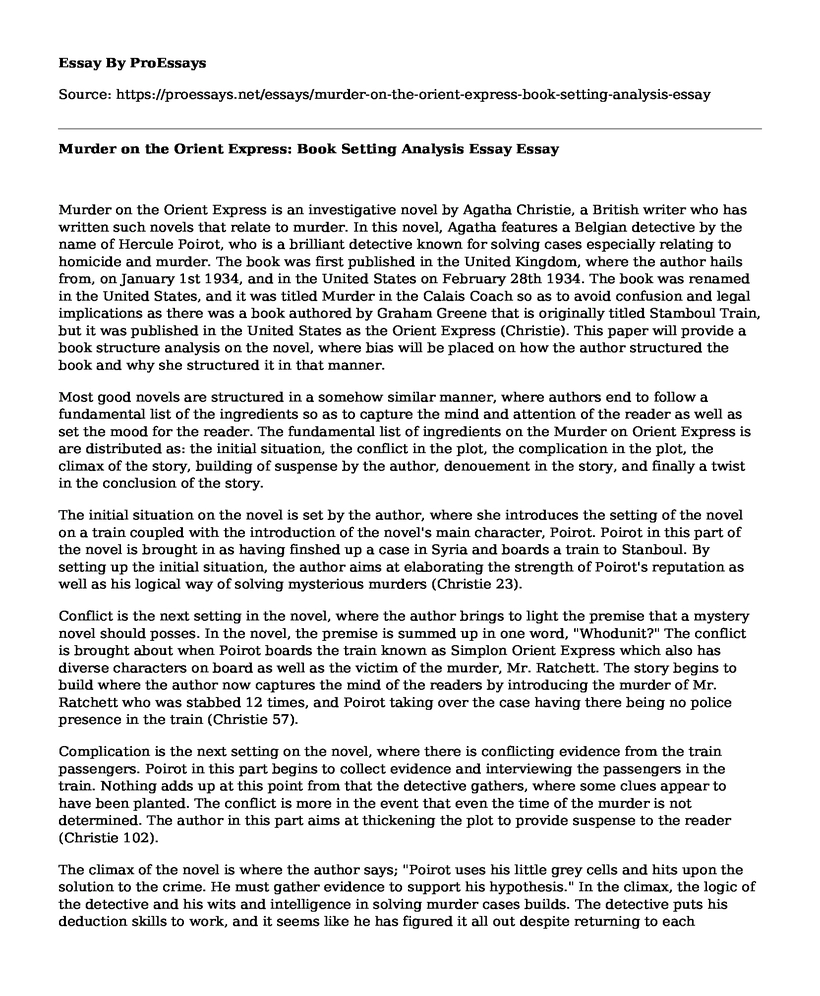Murder on the Orient Express is an investigative novel by Agatha Christie, a British writer who has written such novels that relate to murder. In this novel, Agatha features a Belgian detective by the name of Hercule Poirot, who is a brilliant detective known for solving cases especially relating to homicide and murder. The book was first published in the United Kingdom, where the author hails from, on January 1st 1934, and in the United States on February 28th 1934. The book was renamed in the United States, and it was titled Murder in the Calais Coach so as to avoid confusion and legal implications as there was a book authored by Graham Greene that is originally titled Stamboul Train, but it was published in the United States as the Orient Express (Christie). This paper will provide a book structure analysis on the novel, where bias will be placed on how the author structured the book and why she structured it in that manner.
Most good novels are structured in a somehow similar manner, where authors end to follow a fundamental list of the ingredients so as to capture the mind and attention of the reader as well as set the mood for the reader. The fundamental list of ingredients on the Murder on Orient Express is are distributed as: the initial situation, the conflict in the plot, the complication in the plot, the climax of the story, building of suspense by the author, denouement in the story, and finally a twist in the conclusion of the story.
The initial situation on the novel is set by the author, where she introduces the setting of the novel on a train coupled with the introduction of the novel's main character, Poirot. Poirot in this part of the novel is brought in as having finshed up a case in Syria and boards a train to Stanboul. By setting up the initial situation, the author aims at elaborating the strength of Poirot's reputation as well as his logical way of solving mysterious murders (Christie 23).
Conflict is the next setting in the novel, where the author brings to light the premise that a mystery novel should posses. In the novel, the premise is summed up in one word, "Whodunit?" The conflict is brought about when Poirot boards the train known as Simplon Orient Express which also has diverse characters on board as well as the victim of the murder, Mr. Ratchett. The story begins to build where the author now captures the mind of the readers by introducing the murder of Mr. Ratchett who was stabbed 12 times, and Poirot taking over the case having there being no police presence in the train (Christie 57).
Complication is the next setting on the novel, where there is conflicting evidence from the train passengers. Poirot in this part begins to collect evidence and interviewing the passengers in the train. Nothing adds up at this point from that the detective gathers, where some clues appear to have been planted. The conflict is more in the event that even the time of the murder is not determined. The author in this part aims at thickening the plot to provide suspense to the reader (Christie 102).
The climax of the novel is where the author says; "Poirot uses his little grey cells and hits upon the solution to the crime. He must gather evidence to support his hypothesis." In the climax, the logic of the detective and his wits and intelligence in solving murder cases builds. The detective puts his deduction skills to work, and it seems like he has figured it all out despite returning to each passenger and tell them the truth. It is discovered that all the passengers are connected to the previous case of the Armstrong family where their daughter was kidnapped and murdered by the victim in question (Christie 145).
Denouement in the novel is achieved when Poirot comes to conclusion in two ways which the author blends in to offer a sweet relief to the reader. The two scenarios that are being offered by Poirot seem to contrast in the sense that one of them seem false while the other feels closer to the truth and the main point. Poirot in this section comes out theatrical and flourishes as the reader gets the real sense and grasp of his ultimate detective skills (Christie 220).
Conclusion
The conclusion of the novel is what can be referred to as; "the icing on the cake," as the readers have already come to their own conclusions and now it is upon them to finish reading the novel so as to grasp the mind of the author. This is where justice is served, where Bouc and Constantine act as judges and must pick the correct solution offered by Det. Poirot. The novel ends in a tension and moral standing as to whether it is a case of justice or revenge. The two men that were chosen as judges conclude that Ratchett served justice by being murdered, and hence, no one was to be prosecuted (Christie 252).
Works Cited
Christie, Agatha. Murder on the Orient Express. Oxford: Collins Crime Club, 1934. Soft copy.
Cite this page
Murder on the Orient Express: Book Setting Analysis Essay. (2022, Jul 08). Retrieved from https://proessays.net/essays/murder-on-the-orient-express-book-setting-analysis-essay
If you are the original author of this essay and no longer wish to have it published on the ProEssays website, please click below to request its removal:
- Analysis of Alexander Pope's "An Essay on Man"
- Summary of the Actions of Hamlet
- I Hear America Singing by Walt Whitman - Poetry Analysis Essay
- Assignment Example on Death of a Salesman by Arthur Miller
- Divine Intervention: Athena's Protection of Odysseus in Homer's Odyssey - Essay Sample
- Critical Essay on The Dignity of Difference: Rabbi Jonathan Sacks' Path to Coexistence
- Essay Example on Chaucer on Women: Obedience & Virgin Mary







